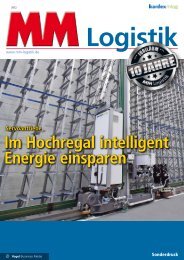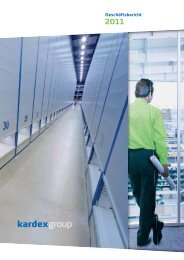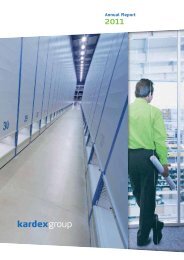You also want an ePaper? Increase the reach of your titles
YUMPU automatically turns print PDFs into web optimized ePapers that Google loves.
ay shelving system. The remaining 10% of the complete<br />
system are taken care of with special and supplementary<br />
parts from traditional production. Stow was equally consistent<br />
when it came to the color range. Parts are only<br />
made in two standard colors, blue and orange. Big<br />
customers like Ikea can have the parts for their high-bay<br />
systems supplied in their corporate colors. Highly qualified<br />
teams of engineers are responsible for making the<br />
system as standardized as possible and for adapting it to<br />
new and ever more creative individual storage solutions.<br />
The secret of rational series production lies in having<br />
seamless production lines for each component. From the<br />
point at which the steel enters the production line and via<br />
profiling, welding, coating, packaging and storage, the<br />
manufacturing process is never interrupted and there is<br />
no intervention by staff. Depending on the volume required,<br />
one or two production lines are available for each<br />
element. Seamless, fully automated production lines like<br />
these cannot be bought “off the peg” on the open<br />
market but were developed by Stow itself, working closely<br />
with automation specialists. The robots were purchased<br />
and then adapted precisely to Stow’s needs.<br />
Offering the most competitive prices on the market, however,<br />
is not achieved simply by automating production<br />
from A to Z. It also means buying in the raw steel at the<br />
best terms: the right quality in the greatest possible<br />
volumes at the lowest price. About two-thirds of the cost<br />
price is determined by the price of the raw material and a<br />
third by personnel and capital costs. With these factors in<br />
mind, it is not difficult to see why Stow leads the market<br />
on costs.<br />
STOW: AMBITIONS IN THE FAR EAST<br />
Since 1996 Stow has had its own production facilities and<br />
distribution organization in Shanghai (China). More than<br />
10% of the total volume is already being produced by the<br />
Stow factory in Shanghai. In view of the local labor market<br />
situation, the first step has simply been to expand the<br />
capacity of the conventional factory. However, should circumstances<br />
in the Far East change, Stow would be ready<br />
at any time to build a fully automated factory. About half<br />
of Stow Shanghai’s customers are European investors<br />
while the other half consists of local Chinese companies.<br />
www.stow.be<br />
STATIC STORAGE SYSTEMS DIVISION<br />
1) Production of standard components at the Stow<br />
factory in Dottenijs (Belgium) is fully automated, from<br />
steel in-feed through to coating.<br />
2) Permanent quality control: every weld seam is<br />
compared with an image of the ideal seam stored<br />
in the system.<br />
3) Handling at the Stow factory in Dottenijs (Belgium)<br />
is almost fully automated, from packaging to removal<br />
from the warehouse.<br />
17









